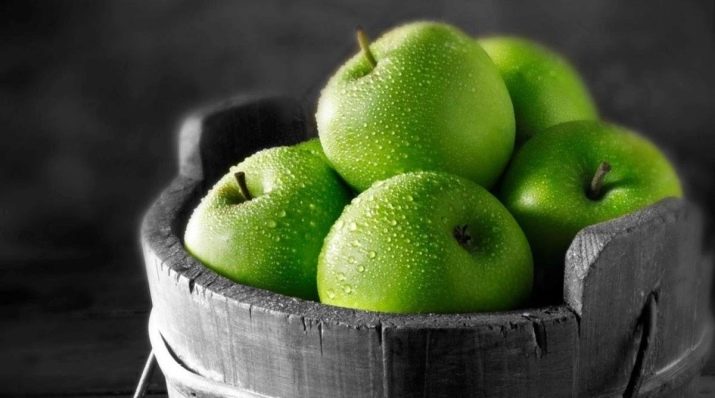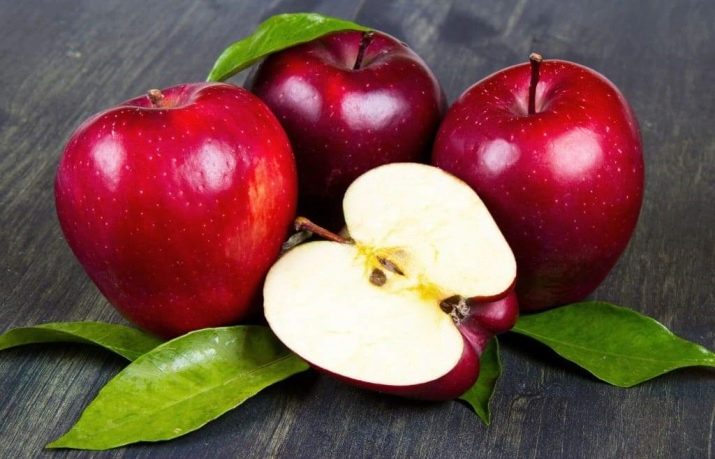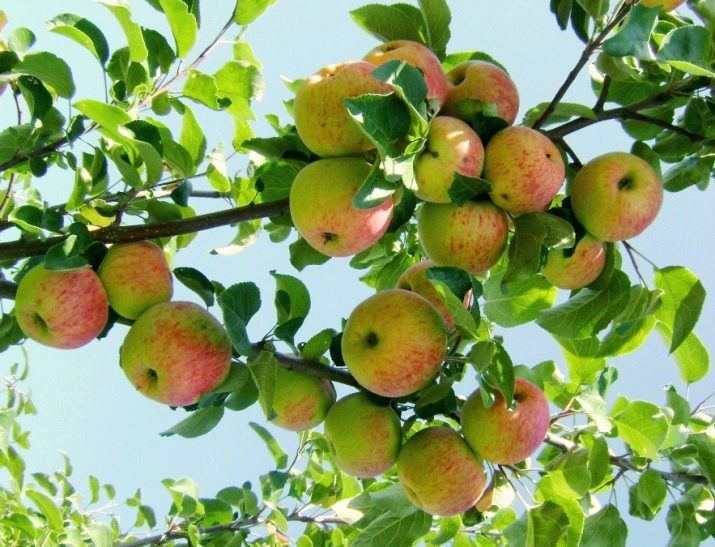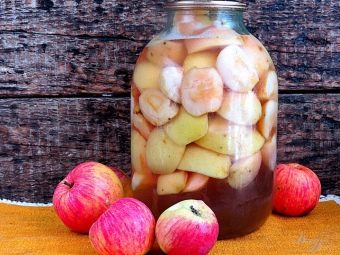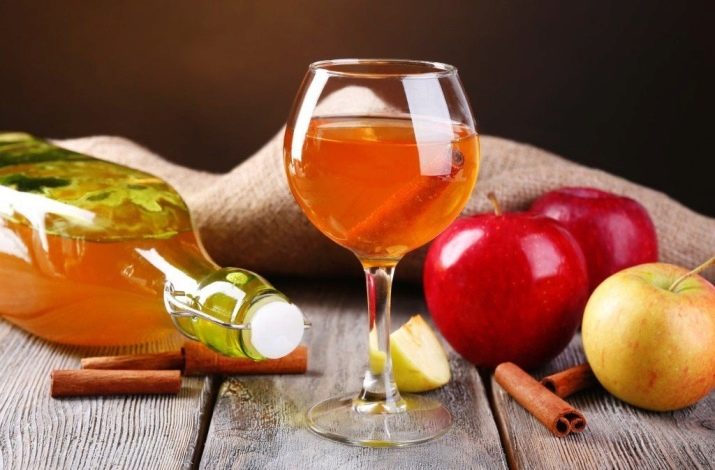Apples: the composition and properties of fruit, caloric content and use of fruits
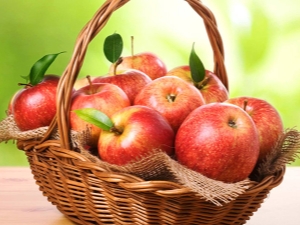
Apple is perhaps the most affordable and popular fruit. However, this in no way detracts from its benefits.This is one of the few fruits that has a beneficial effect on all human organs and at the same time has a minimum (more precisely, almost no) contraindications.
Description and composition
Apple is the fruit of a deciduous plant - an apple tree. The latter belongs to the Rosaceae family, has bright spherical fruits. Their taste is diverse and ranges from sour to sweet varieties.
The unpretentiousness of the culture, the magnificent taste of the fruit, the incredibly beautiful blooming of apple trees in spring - all this makes the culture one of the most popular in the world, including in Russia. There are domestic and wild varieties of apple. The first allegedly appeared in Central Asia. There is also an opinion that the first sweet fruits that appeared on wild apples can be considered the homeland of the Caucasus Mountains.
The life of domestic apple trees is up to 100 years, wild - up to 300. Active fruiting lasts an average of fifty years, and begins at 4-12 years after planting (depending on the variety, peculiarities of care)
In April and May, the flowering of apple trees begins, as well as their cross-pollination. In June-July, ovaries are formed, and from mid-summer to late September and early October, fruiting occurs. In different varieties it falls on different periods - there are early ripe apples (“Ranet”), there are those that ripen in September (“Antonovka”).
An apple is a juicy fruit, since about 80% of its composition is structured water, in its characteristics it is close to the liquid that bathes human internal organs. Vitamins and minerals are dissolved in this liquid - A, C, PP, B, as well as vitamin G, sodium, potassium, magnesium, iodine, iron, calcium and other substances rare for fruit.
The taste of apples is largely due to the percentage ratio in the fruits of organic acids and sugars. Both of these components are present in all apples, but some (more acidic varieties) have an increased amount of organic acids and less sugars. With sweet varieties, everything is exactly the opposite (they have a higher sugar content than acids).
The fruit contains malic, citric, tartaric acids, antioxidants (most of which are found in the peel), pectins, dietary fiber, tannins. Also, apples have polyphenols - these are biological compounds responsible for the taste and quality of fruits. It is they who provoke the darkening of the apple after its peeling or cutting into pieces. Such a reaction helps protect the fetus from the action of bacteria and germs.
There are also flavonoids in fruits, which are also biologically active substances. Of the most famous - quercetin, myricetin, kaempferol.
The composition of apples of different varieties may differ slightly. For convenience, they are usually attributed to one of three groups.
Green
Most of these apples have a sour taste, which indicates their low calorie content (organic acids in the composition predominate over sugars), and therefore green apples are called dietary. Scientists have proven that they contain more vitamin C and have lower glycemic index (GI).
Red
Red apples are usually sweet, and therefore more nutritious. A beautiful skin tone is due to the presence of anthocyanins in the composition of the pigments.
Yellow
Yellow fruits usually have a sweet or sour-sweet taste and their caloric content, glycemic indicators can be considered an intermediate option between green and red. Most of them contain less iron than green, but they are rich in pectin.
The concentration of nutrients is observed in the skin of the apple, and most of the iodine is contained in the pits. In addition, in the latter there is a special substance amygdalin.
These components of the composition are fully manifested in the freshly picked fruit. In this regard, the most useful apples - those that are grown with their own hands and plucked during the period of technical maturity and literally immediately after that are eaten.
Calorie content
The energy value of apples is determined by the presence of carbohydrates in them, so there are more and less high-calorie fruits. Let's start with a general indicator - on average, the energy value of 100 g of fresh apple is 47 kcal. In this case, BZHU looks like 0.4 / 0.4 / 9.8 g.
Since very few people eat fruit at 100 grams, it is more logical to indicate the approximate caloric content of the whole fruit. For an average-sized apple (weighing 80-90 g), this indicator is 36-42 kcal, for a large one (weighing 170-200 g) - 100 or slightly more calories.
Speaking of sweet varieties, the indicators of carbohydrates increase (sometimes up to 15 g), and with them the values of the energy value. The coefficients of proteins and fats usually remain unchanged. On average, the energy value of red and most yellow apples varies between 50-70 kcal per 100 g of product, in some cases it can reach 80-90 kcal.
For example, the famous red apples “Idared” have a caloric content of 50 kcal / 100 g, and yellow “Golden” - 53 kcal.
However, even within the limits of apples of one group, their caloric content varies. So, for example, the Golden Smith and Semerenko apples are fruits with green skin and an acidic taste. However, the calorie content of the first is almost 48 kcal (carbohydrates account for 9.7 g), and the apples “Semerenko” have an energy value of 40 kcal (9.2 g).
These figures are true for fresh fruit, but during heat treatment their caloric content changes. Perhaps, to the greatest extent, it grows in dried apples. This is due to the fact that moisture is completely evaporated from them, which increases the concentration of sugar in the composition. On average, the indicators of energy calories in apple dried fruits are 200-250 kcal / 100 g. More accurate indicators depend on the caloric content of raw materials.
Dried fruits can be even more high-calorie, here the minimum caloric threshold is 240-250 kcal.
Baked apples have the same caloric content as fresh ones, but on condition that no additives are used to make them. So, when using honey, the energy value increases by 100-150 kcal / 100 g.
As for jam and jam from apples, their caloric content depends on the type of fruit used and the amount of sugar. On average, it is 130-150 kcal per 100 g of product. To reduce these figures can be, using sugar substitutes.
Fresh apple juice contains about 40-42 kcal. This value is true for drinks made by hand without adding sugar from raw materials with green skin (green apples, by the way, are the most succulent). In most store juices, calories are significantly higher than indicated because they contain sugars and preservatives.
Benefit
The benefits of these fruits due to the richness of their chemical composition. First of all, it is necessary to note the immunostimulating and strengthening effect of fruits. Due to this, it is possible to increase the body's resistance to viral and catarrhal diseases, adverse effects of the external environment.
Immunostimulating and anti-cold effects are explained not only by the high content of vitamin C in apples, but also by vitamin A. The content of the latter in these fruits is 50% higher than the amount of the same vitamin in oranges. In addition, vitamin A is necessary to maintain visual acuity.
Very useful apples for digestion. Vitamin G stimulates the appetite, and organic acids help the stomach to digest food faster and better. They act like gastric juice, so apples (preferably sour to taste) are especially useful with low acidity of the stomach.
Fiber helps to increase intestinal motility, which is also better digestion. In addition, swelling in the stomach and intestines, it gives a feeling of satiety, but most importantly - being an indigestible element, it moves through the intestines and collects, and then removes slags and toxins.
Well-functioning organs of digestion - a pledge of fast metabolic, in particular, lipid metabolic processes. This, in turn, provides body cleansing and weight loss. That is why apples, primarily green ones, are recommended for those on a diet.
Thanks to the fiber and pectin in the apples, they show a mild laxative effect. Doctors recommend eating 1-2 apples a day to get rid of constipation.
Useful for apples and athletes. First, as already mentioned, they improve digestion (which is important for those who are “on the ground”), but they are low in calories and do not provoke blood sugar jumps. Secondly, apples contain ursolic acid, which prevents muscle wasting. To a greater extent, this compound is present in the peel of apples. It helps maintain muscle shape and reduces the likelihood of fat deposits.
Antioxidants and vitamin PP in the composition of the fruit allows you to judge their benefits for blood vessels. Regular consumption of fruits helps to reduce the level of "bad" cholesterol in the blood, reduces the formation of cholesterol plaques on the inner walls of blood vessels. Under the influence of nicotinic acid (vitamin PP), the permeability of small vessels (capillaries) is improved. Due to this, all tissues (even those that do not have veins and arteries on their “territory”) receive adequate nutrition.
Apples cannot be called an effective source of iron, however, due to the combination with acids and “ascorbic”, this trace element is absorbed almost completely. Moreover, if you combine other products rich in iron with an apple, then under the influence of the acids they contain, the absorption of iron from them will improve.
Potassium and magnesium strengthen the heart muscle, contribute to the normalization of rhythm. Such an effect of apples on the cardiovascular system reduces the risk of atherosclerosis, heart attack, stroke, and helps to recover from the same ailments, helps reduce blood pressure during hypertension.
Returning to the antioxidants found in apples, it is worth noting that, thanks to them, these fruits, according to research, help protect the body from breast, skin, colon and lung cancer, and the components of the fruit inhibit liver cancer.
The high content of B vitamins makes the fruit beneficial for the nervous system. It has been proven that with regular consumption of apples, it is possible to reduce the likelihood of developing Alzheimer's disease due to the fact that apple components protect neurons from neurotoxicity. In addition, apples rich in beneficial components strengthen the nervous system, tone up the body and improve cerebral circulation, which is especially useful with elevated emotional and mental stress.
In addition, a large amount of vitamin B has a beneficial effect on the skin - the work of the sebaceous glands is regulated, nutrition improves, and with it the skin color. We should not forget about the antioxidant effect of apples - they, as already mentioned, slow down the aging process. It is not surprising that these fruits consume inwards and are used externally in the form of face masks for those who seek to preserve the beauty and youthfulness of the skin.
Acid varieties of apples help reduce blood sugar, and by influencing the pancreas, they help it to produce insulin. This makes the fruit one of the fruits that help prevent diabetes. The glycemic index of fruits is 30-50 units, which allows diabetics to consume some varieties daily. Moreover, with type 2 sugar disease, unsweetened apples with regular consumption also help to maintain blood sugar levels. In addition, they normalize the metabolic imbalance that inevitably accompanies the disease.
Thanks to special ingredients, apples reduce oxalic acid concentration in the body.the latter causes the formation of oxolates, or salts, which are formed in the ureters, kidneys. In other words, apples help prevent the development of urolithiasis, diseases of the joints (gout, rheumatoid arthritis) caused by the deposition of salts in the joint tissue.
In addition, fruits show a mild diuretic effect, and therefore are useful for preventing cholelithiasis, cholecystitis. At the same time, fresh juice of apples demonstrates greater efficiency, which is taken twice a day for a quarter of an hour before a meal.
Apple juice reduces the breakdown of formic acid and inhibits uric acid, so that fruits have a beneficial effect on the skin - they help in the treatment of dermatological diseases caused by nervous disorders. Apples should be included in the diet of those who suffer from chronic eczema, dermatitis.
The content of iodine in apples is also at a fairly high level. For comparison, an apple contains 8 times more iodine than a banana and 13 times more than an orange. This makes them especially useful for people with thyroid problems. Basically, all iodine in apples is concentrated in seeds.
In addition to iodine, they contain a substance called amygdalin. When it enters the stomach, it breaks down and forms a toxin, hydrocyanic acid. However, amygdalin in the pits is contained in minimal quantities, so eating 1-2 apples with pits per day will only benefit and will not cause poisoning. It is better for children not to give fruit with bones, but not because of the amygdalin contained in them, but due to the fact that babies can choke on the seeds of the fruit.
Apples can be considered as natural “brushes” for teeth. As it is known, sufficiently hard fruits and fresh vegetables must be present in the human diet (not cut into slices, not grated through a grater). Thus, the teeth are cleaned, the gums are massaged. Apples are optimal for these purposes, since they also have an antibacterial effect.
Harm
Apples are considered a hypoallergenic product, but in some cases their individual intolerance is possible. Quite often it is found in people who are allergic to the pollen of apple trees. In addition, allergies are possible for red apples containing pigment.
Sweet varieties have a high sugar content. And although it is mostly represented by fructose, sweet fruits may be contraindicated in diabetes and obesity.
Acid varieties, in contrast, contain many organic acids, and therefore they can adversely affect the gastric mucosa, which have inflammation and damage. Thus, sour apples should be used with caution in gastritis, peptic ulcer and other inflammatory processes of the digestive tract. During the period of exacerbation, such fruits should be completely excluded from their diet.
If you are prone to diarrhea, excessive consumption of these fruits can cause deterioration. Sometimes apples, especially with a dense skin, can cause increased intestinal motility and abdominal discomfort. In this case, you should look for other varieties of fruit, remove the skin before use, or bake the fruit.
In case of thrush and other yeast infections, the condition of the patient may worsen, therefore, with these diseases, apples can be harmful.
Like any product, apples require moderate consumption. Failure to follow this rule may cause abdominal pain, intestinal colic, and stool disorders.
With increased sensitivity of teeth, bleeding gums, consumption of fresh fruit can bring discomfort. In this case, it is better to use apple fresh juice, and to do this through a straw, so that the acids in the composition of the drink do not destroy the tooth enamel.
Pregnancy and lactation are not a contraindication to the use of fruit. On the contrary, apples are useful to women in this period.True, it is better to give preference to green fruits (they do not have a pigment that can provoke an allergy) and not too sweet yellow apples. In the last weeks of pregnancy, overstimulation of the colon can cause uterine contractions, fraught with premature birth. Reducing the activity of the intestines when consuming apples will help them bake.
During breastfeeding, it is better to eat apples also green, focusing on the health of the baby. It is possible to introduce this fruit into the diet of a nursing mother already from 1.5-2 months after delivery, provided that there are no allergic reactions in the infant, or abnormalities in the functioning of his GIT organs.
Harm can also be caused by store apples, which, in order to make them more attractive, or to improve transportability, the keeping quality of fruits “pump up” or cover with chemistry. Such compounds, accumulating in the body, can provoke dangerous diseases when a certain concentration is reached. However, in people with allergies, asthma and in young children, even a single consumption of such fruits can trigger an allergic attack.
Popular varieties
Depending on the appearance, taste and composition, apples are sour (usually green), sweet (usually red) and sour-sweet (yellow). Early ripening, mid-ripening and late varieties are classified according to the degree of ripening. There are varieties that are used for fresh consumption and preparation of blanks (usually summer varieties), as well as those that are good for storage (fruits collected in late autumn).
Let us consider in more detail the most popular varieties, based on the criteria for the degree of their maturation.
Summer
"Papirovka"
Apples are yellow-green in color, as if with a transparent skin. To taste sweet and sour, juicy. The distinctive characteristic is the seam running all over the fruit. Lasts in early-mid-August, is not used for storage and transportation.
"Melba"
“Melba” apples are characterized by appetizing and attractive “appearance” - the rounded-conical fruits are painted in a transparent green shade, and on one of the sides are red stripes. Fruit ripening dates from the beginning of August, they are stored for about a month, and are well transported. Melba apples are rather large, the mass of each reaches 200-220 g. The juicy soft pulp is characterized by a sweet-sour taste.
"Early Sweet"
The size of the fruit is small (weighing up to 100 g each), they have a pleasant sweetish taste, dense white flesh. Ripen in the last days of July and early August.
"White filling"
A variety of yellow apples with a pleasant fruity aroma and juicy pulp that tastes sweet. Fruits are small (up to 100-110 g each) oblong, as if egg-shaped.
Borovinka
Quite often found fruits that are easily recognizable by the characteristic reddish blush that goes over the yellow skin. Small apples (average weight is 100 g), rounded. Borovinka has a sweet and sour taste and tender juicy flesh. The time of ripening is the end of summer and the beginning of autumn.
Autumn
"Anise"
Small (weighing 70-80 g) yellow-green apples with a red blush and a characteristic wax coating. Apples are also known for their juiciness, aroma and sweet-sour taste. Rush to the beginning of autumn and in the cellar can be stored until the onset of winter. The variety has several varieties - "Anis striped / Sverdlovsk."
"Oryol Festoon"
One of the main advantages of these small apples is the storage time. Subject to the requirements, they can lie in the cellar until the end of winter-early spring. The shape is similar to the turnip, the skin color is golden with a slight reddish blush. The flesh is tender, white with a slight greenish tint, juicy and more sweet, although it is usually indicated as sour-sweet.
"Saffron"
Quite large apples (with an average weight of 120-140 g) are elongated, more precisely, of conical shape and with a peel of yellow-green hue.On the sides they are covered with red dots that form a blush. The fruits are attractive in appearance, so they are often grown for sale. Their flesh is juicy, tender, slightly grainy, the taste is sweet and sour.
Winter
"Antonovka"
It is considered, perhaps, one of the most famous late-ripening varieties, the ripening of fruits of which fall at the end of September and beginning of October. Large fruits (average weight - 200 g) are shaped like a slightly flattened ball and have a greenish-yellow transparent skin color. One of the features of the variety is the heady apple flavor. The pulp with a large amount of juice has a white color, sourish taste.
"Aport"
This variety in size and weight of the fruit is similar to that described above, but its fruits are sweeter. These are apples of conical shape, yellow-green. However, most perceive them as red because of the blush that covers the fruit almost entirely.
The described varieties are usually grown in cottages and in home plots. In season, they can be found in local markets and fairs. In stores, they usually sell other types of fruit. Let us dwell on some of them.
"Idared"
Homeland varieties - USA, where they appeared in 1935. Fruits have a rounded elongated shape, greenish-yellow skin with a red blush. The structure of the pulp is dense, its taste is sweet and sour. “Idared” is not suitable for storage, it is better to eat it right away or use it for making compotes, baking, as well as for making dried fruits.
Granny Smith
Variety of Austrian origin, which quickly gained popularity due to its juiciness, hypoallergenicity and low calorie content. It is these apples among the other varieties of green fruit are most often found on the shelves of supermarkets. You can recognize them by a fairly large size, rounded shape and beautiful green skin. It is noteworthy that the fruits do not have apple or other fruit flavor. "Granny Smith" are good in salads and cuts, because they do not darken when sliced. Juice can be made from them, and baking with these apples is successful.
"Jonathan"
Small and fragrant apples with dark red blush not only delight the taste, but also decorate any shop window. Another advantage is the possibility of long-term storage. Collected in late September, they are well kept until spring. Good for cooking compotes, sauces, baking, but for roasting it is entirely better to pick up fruits of a different sort. "Jonathan" in this case does not hold the form and spreads.
"Pink Lady"
Under this name are beautiful apples with a red blush, glossy skin. They have a slightly elongated shape, crunchy flesh, sweet and sour in taste. According to studies, this species can claim to be the champion in its content of flavonoids and antioxidants.
Red Chief
Fruits admire their noble appearance. Apples have a markedly elongated shape and rich burgundy skin tone. The flesh is tender, white, the taste is sweet, although it cannot be called juicy. Apples ripen in September, but it is better to taste them after 2-3 months. In general, stored up to 7-8 months.
Fuji
Fruits, whose birthplace is Japan. Fuji apples have a round shape and a red-raspberry skin color. The taste is sweet, some even talk about cloying. Harvesting is carried out at the end of October and they still have a slight acidity, which disappears as the Fuji is stored.
Application of fruits
The easiest and most affordable way to use apples is to eat them fresh. It is important not only to wash it under running water, but also to scald it with boiling water. So from garden fruits you can destroy parasites and helminth eggs (they are often found on apples, especially those that are harvested from the ground), and from the store fruits - a layer of wax, which is usually covered with fruits before selling.
Apples can be served as a dessert or an independent snack.For variety, you can include them in salads, and the fruits are combined with both fruit and vegetable dishes. In the first apples are harmoniously combined with pears, bananas, citrus, strawberries, cherries. For dressing, you can use yogurt, kefir, low-fat sour cream.
Apple is good in the "company" of almost all fresh vegetables and greens. In addition, it can often be found with chicken breast and seafood in salads.
As an independent dessert, you can offer a baked apple. You can also bake it by removing the core and filling the fruit with cottage cheese, nuts, and dried fruit. Honey, toppings, hot chocolate, which you can pour the baked fruit, will help to add sweetness to the dish.
As a dessert, apples can be baked. The most famous, of course, is the charlotte. In addition, portion cakes are made from fruit, used in the composition of muffins, cakes, as well as for decorating sweet dishes.
However, apples can be baked not only as a sweet dish. Baked fruit can be served with meat or fish. The goose or duck with apples is very popular. However, slices baked fruits go well with pork, turkey, rabbit, especially if served with apple chutney (fruit and berry sauce), apple-currant or cranberry sauce.
For preservation for the winter, they are preserved by cooking compotes and jams. Due to the high content of pectin in the composition of apples, jam is obtained, jams that do not require the addition of gelatin and similar products to the recipe. The resulting jams and jams, in turn, can be the basis for other dishes - impregnation of biscuits, fillings for cheesecakes, etc.
Sweet harvesting is not the only option to save apples for the winter. Often they are included in the composition of ketchup, savory sauces (chutney, tkemali).
Due to its juiciness, apples give a lot of juice, compotes are also prepared from them. If desired, and the appropriate technology of cooking these drinks can be preserved.
Another option of winter preparations from apples is their drying. To do this, it is better to choose less sweet varieties and use an electric dryer for fruits and vegetables or dry slices or circles of apples in the oven.
With natural drying, the juice from them evaporates very slowly, and therefore the likelihood of fruit rotting is high. In addition, drying in natural conditions (laid out on a tray or strung on strings) is fraught with the attraction of mosquitoes and insects to fruits.
Soaking them helps to preserve the beneficial properties of apples. Long since soaked apples harvested for the future in wooden coils. Given the modern realities of life, today, glass jars and oppression are used for soaking, which does not impair the taste at all and does not reduce the usefulness of fruits.
For soaking, it is better to use autumn apples, which should have a sufficiently dense skin and flesh, but already be ripe. Such varieties as “Antonovka”, “Titovka”, “Pipin” and similar types are best suited for soaking.
It is important to pick whole apples without damage and traces of rot. Soaking involves the saturation of fruit liquid, which contains preservatives. It is important that in the process of cooking the apples are completely submerged under water. Otherwise, if some of them will be out of the brine, the process of decay will begin, which will quickly spread to the entire composition.
Thanks to pectin in the composition of the apples are also used for the manufacture of marmalade, jelly. Moreover, in industry this pectin is extracted from apples and then used in the manufacture of all the same marmalades, marshmallows.
The high content of sugars allows you to use the fruit for the preparation of alcoholic beverages. Among the most famous are low-alcohol cider, the national French drink Calvados (something close to brandy), as well as various fruit and berry wines. Among non-alcoholic (low-alcoholic) drinks, it is worth noting apple kvass, which has a pleasant aroma and slightly sour taste.
If kvass is obtained at home during the fermentation process (it is not produced in industrial volumes yet), apple vinegar is prepared on the same principle at plants.
Fruits are not only applied inwards, but are used externally. On the basis of apple gruel make moisturizing and nourishing masks. When using more acidic apples get compositions for oily and problem skin, as well as those that demonstrate a whitening effect.
In the cosmetic industry, apple extract is used to add to creams and shampoos. On the basis of an organic acid extracted from fruits, preparations are prepared for peels, foot care.
5 recipes for cooking apples, which are now just for you, see the next video.




